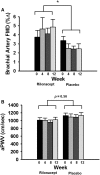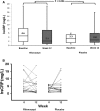IL-1 Inhibition and Vascular Function in CKD
- PMID: 27647856
- PMCID: PMC5328163
- DOI: 10.1681/ASN.2016040453
IL-1 Inhibition and Vascular Function in CKD
Abstract
Vascular endothelial dysfunction and increased arterial stiffness contribute to increased cardiovascular risk in patients with CKD who exhibit chronic systemic inflammation. Because chronic inflammation contributes to vascular dysfunction, blocking inflammation may reduce cardiovascular risk in patients with CKD. In a two-site, double-blind trial, we randomized 42 adult patients with stage 3-4 CKD who were already receiving optimal background therapy to receive either IL-1 trap rilonacept or placebo for 12 weeks. Coprimary end points included change in brachial artery flow-mediated dilation (FMDBA) and aortic pulse-wave velocity (aPWV) after 4, 8, and 12 weeks. Exploratory end points included change in high-sensitivity C-reactive protein (hsCRP), FMDBA after acute ascorbic acid infusion, and vascular endothelial cell protein expression of NADPH oxidase. Participants were 63±11 (mean±SD) years of age and 24% were women; mean eGFR was 38±13 ml/min per 1.73 m2 Compared with placebo, rilonacept improved FMDBA (baseline: 3.36%±2.06% [mean±SD], 12 weeks: 2.45%±2.29% with placebo and baseline: 3.75%±3.12%, 12 weeks: 4.86%±3.20% with rilonacept; P<0.01), without changing aPWV (P=0.56). Rilonacept also reduced hsCRP levels (median [interquartile range]) (baseline: 4.60 [1.90-8.22] mg/L, 12 weeks: 2.16 [0.92-7.38] mg/L; P<0.01) and endothelial cell NADPH oxidase expression (P<0.05). Acute infusion of ascorbic acid to inhibit superoxide production associated with a nonsignificant trend toward increased FMDBA in the placebo group (P=0.07) but not the rilonacept group (P=0.56). Rilonacept was well tolerated (five adverse events versus two with placebo). In conclusion, treatment with an IL-1 trap improved FMDBA without changing aPWV and reduced systemic inflammation in patients with CKD.
Keywords: chronic kidney disease; clinical trial; endothelium; pulse wave velocity; randomized controlled trials; vascular.
Copyright © 2017 by the American Society of Nephrology.
Figures



Comment in
-
Inflammation as a Therapeutic Target To Improve Vascular Function in Kidney Disease.J Am Soc Nephrol. 2017 Mar;28(3):723-725. doi: 10.1681/ASN.2016111173. Epub 2017 Jan 3. J Am Soc Nephrol. 2017. PMID: 28049650 Free PMC article. No abstract available.
References
-
- Henderson LW, Koch KM, Dinarello CA, Shaldon S: Haemodialysis hypotension: the interleukin hypothesis. Blood Purif 1: 3–8, 1983
-
- Shlipak MG, Fried LF, Crump C, Bleyer AJ, Manolio TA, Tracy RP, Furberg CD, Psaty BM: Elevations of inflammatory and procoagulant biomarkers in elderly persons with renal insufficiency. Circulation 107: 87–92, 2003 - PubMed
-
- Oberg BP, McMenamin E, Lucas FL, McMonagle E, Morrow J, Ikizler TA, Himmelfarb J: Increased prevalence of oxidant stress and inflammation in patients with moderate to severe chronic kidney disease. Kidney Int 65: 1009–1016, 2004 - PubMed
-
- Descamps-Latscha B, Herbelin A, Nguyen AT, Roux-Lombard P, Zingraff J, Moynot A, Verger C, Dahmane D, de Groote D, Jungers P: Balance between IL-1 beta, TNF-alpha, and their specific inhibitors in chronic renal failure and maintenance dialysis. Relationships with activation markers of T cells, B cells, and monocytes. J Immunol 154: 882–892, 1995 - PubMed
-
- Pereira BJ, Shapiro L, King AJ, Falagas ME, Strom JA, Dinarello CA: Plasma levels of IL-1 beta, TNF alpha and their specific inhibitors in undialyzed chronic renal failure, CAPD and hemodialysis patients. Kidney Int 45: 890–896, 1994 - PubMed
Publication types
MeSH terms
Substances
Grants and funding
LinkOut - more resources
Full Text Sources
Other Literature Sources
Medical
Research Materials
Miscellaneous

